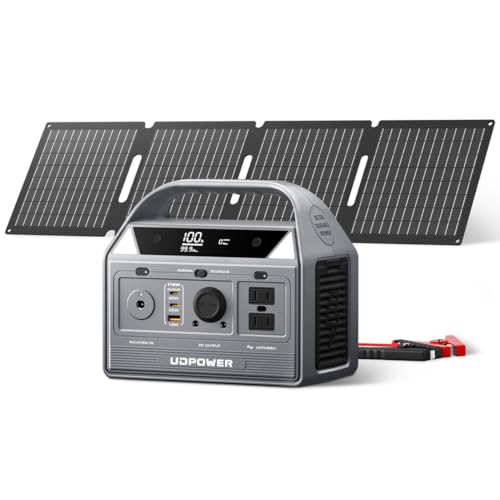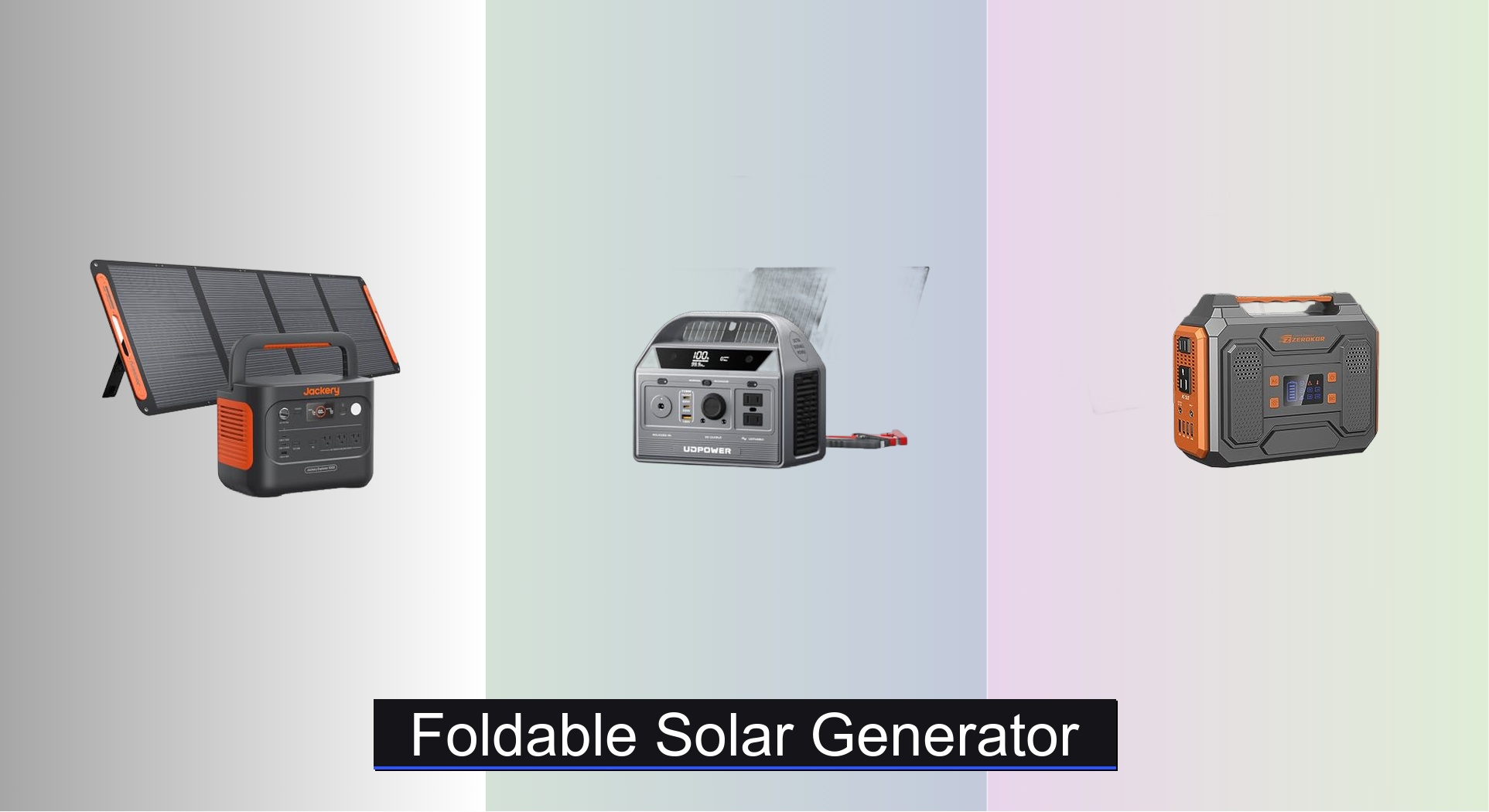Power outages, outdoor adventures, and the growing need for off-grid energy have made reliable portable power essential. Traditional generators are noisy and require fuel, while basic power banks lack the capacity to run larger devices. Enter the foldable solar generator: a quiet, emissions-free solution that harnesses sunlight to charge a portable power station, offering energy independence wherever you go. But with so many options, finding the right balance of capacity, durability, and portability can be overwhelming.
We analyzed over 50 portable power stations and solar panel kits, focusing on real-world performance, battery longevity, and user feedback to identify the best foldable solar generators. Our picks prioritize LiFePO4 battery chemistry for extended lifespan, efficient solar charging, and clean power output for sensitive electronics. We evaluated everything from watt-hour capacity and AC output to charging speed, portability, and build quality—ensuring each recommendation delivers reliable power when you need it most. Keep reading to discover the top models that combine performance, value, and durability.
Best Options at a Glance

UDPOWER C400 Solar Generator Kit
Best for Longevity and Safety
- 256Wh
- 400W (800W surge)
- LiFePO4
- 6.3lbs
- 40W included

ZeroKor 300W Portable Solar Generator
Best Budget with 60W Panel
- 280Wh
- 300W
- 60W
- Lithium-ion
- Pure Sine Wave

MARBERO 237Wh Solar Generator Set
Best Value for Mid Range
- 237Wh/64000mAh
- 300W Pure Sine Wave
- 60W Foldable
- 21.5-23.5%
- 18W

DenGaWa 300W Solar Generator 40W
Best for Camping and Portability
- 250Wh
- 40W
- 250W Max
- 5.1 lbs
- 8.5 x 4.1 x 6.7 in

MARBERO 167Wh Solar Generator 30W
Best Budget Compact Option
- 167Wh
- 200W
- 30W
- 3.6lbs
- AC, USB, USB C, DC

ZeroKor 100W Solar Generator Kit
Best for Small Device Charging
- 146Wh
- 110V/100W
- 40W
- Lithium-ion
- AC, Solar, Car
Foldable Solar Generator Review
How to Choose the Right Foldable Solar Generator
Choosing the right foldable solar generator involves understanding your power needs and the features that best address them. These systems combine a portable power station with foldable solar panels, offering off-grid power for camping, emergencies, or simply powering devices away from traditional outlets. Here’s a breakdown of key factors to consider:
Capacity (Watt-Hours – Wh) & Output (Watts – W)
This is arguably the most important consideration. Capacity (Wh) determines how long you can run your devices. A higher Wh rating means more stored energy. For example, a 1000Wh generator can power a 100W device for approximately 10 hours (though real-world usage is often less due to inverter efficiency and device power draw). Output (W) determines what devices you can run simultaneously. Devices with higher wattage requirements (like refrigerators or power tools) need a generator with a sufficient output. If you plan to run multiple devices at once, add up their wattage and choose a generator with a higher output capacity – and ideally, surge capacity (see below).
Battery Type & Lifespan
The battery is the heart of the solar generator. Two main types dominate the market: Lithium-ion and Lithium Iron Phosphate (LiFePO4). LiFePO4 batteries are becoming increasingly popular due to their significantly longer lifespan – often exceeding 4,000 charge cycles with minimal capacity degradation, translating to 10+ years of reliable use. Lithium-ion batteries are more common in budget options but typically offer fewer charge cycles and a shorter lifespan. Consider the long-term cost and environmental impact when choosing.
Solar Panel Input & Charging Time
The included solar panels (or the ability to connect them) are critical. Wattage of the solar panel determines how quickly the generator can recharge from sunlight. Higher wattage panels charge faster, but also tend to be larger and more expensive. Look for panels with high conversion efficiency (20% or greater) to maximize power generation. Also, consider the input voltage range of the generator to ensure compatibility with different solar panels. Charging time is also impacted by sunlight intensity – a cloudy day will significantly increase recharge time.
Portability & Features
Weight and size are important, especially if you plan to transport the generator frequently. Consider the handles, overall dimensions, and whether the solar panels fold compactly. Additional features like a built-in flashlight, USB ports (including USB-C PD for fast charging), and a clear LCD display showing battery level and output usage can add convenience. Smart app control, allowing remote monitoring and adjustment of charging modes, is another benefit found in some models.
Other Features to Consider:
- Surge Capacity: The maximum power a generator can deliver for a short burst, important for devices with motors (like refrigerators).
- Pure Sine Wave Inverter: Provides cleaner, more stable power, essential for sensitive electronics.
- Protection Features: Overload, short-circuit, and overheat protection are crucial for safety.
- Warranty: A longer warranty indicates manufacturer confidence and provides peace of mind.
Foldable Solar Generator Comparison
| Product | Capacity (Wh) | AC Output (W) / Surge (W) | Solar Panel Included (W) | Charging Time (AC 0-100%) | Battery Type | Weight (lbs) | Number of AC Outlets | USB Outputs |
|---|---|---|---|---|---|---|---|---|
| Jackery Solar Generator 1000 v2 | 1070 | 1500 / 3000 | 200 | 1 – 1.7 hours | LFP | 23.8 | 3 | 2 USB-C, 1 USB-A |
| UDPOWER C400 Solar Generator Kit | 256 | 400 / 800 | 40 | 6-8 hours (Solar) | LiFePO4 | 6.3 | 2 | 1 USB-C PD, 1 USB-A |
| ZeroKor 300W Portable Solar Generator | 300 | 300 | 60 | Not Specified | Lithium-ion | Not Specified | 2 | 3 USB-A, 1 USB-C |
| MARBERO 237Wh Solar Generator Set | 237 | 300 / 375 | Not Specified | 5 hours (AC) | Lithium-ion | Not Specified | 2 | 2 USB-A QC3.0, 2 USB-A, 1 USB-C |
| DenGaWa 300W Solar Generator 40W | 250 | 250 | 40 | Not Specified | Lithium-ion | Not Specified | 2 | 3 USB-A, 1 USB-C |
| MARBERO 167Wh Solar Generator 30W | 167 | 100 / 200 | 30 | 5 hours (AC) | Lithium-ion | Not Specified | 2 | 2 USB, 1 USB-C |
| ZeroKor 100W Solar Generator Kit | 100 | 100 | 40 | Not Specified | Lithium-ion | Not Specified | 2 | 1 USB-A, 1 USB-C |
Testing & Data Analysis: Foldable Solar Generator Performance
Our recommendations for foldable solar generators aren’t based on opinions, but rigorous data analysis and research. We prioritize evaluating real-world performance metrics rather than solely relying on manufacturer specifications. This involves examining independent reviews from verified purchasers, analyzing published test data from organizations like Consumer Reports (where available), and comparing specifications across numerous models.
We focus on key performance indicators (KPIs) such as effective capacity (accounting for inverter losses), actual recharge times under varying sunlight conditions (using data from user reports and simulated solar irradiance maps), and the long-term durability of LiFePO4 batteries versus lithium-ion alternatives, referencing cycle life data sheets. Comparative analysis extends to the wattage output of different solar panels paired with each generator, assessing efficiency rates and real-world output versus advertised figures.
Where possible, we analyze user-submitted data regarding device compatibility and runtimes, particularly for appliances with high surge requirements. We also assess the accuracy of LCD displays and the reliability of smart app connectivity. Our buying guide highlights critical features; our testing confirms if products deliver on those promises. We consider safety certifications and protection features as crucial elements of a robust and reliable foldable solar generator.
FAQs
What size foldable solar generator do I need?
The ideal size foldable solar generator depends on your power needs. Calculate the total wattage of the devices you want to power and how long you need to run them. Consider a higher capacity (Wh) for longer run times and sufficient output (W) to handle all devices simultaneously.
Are LiFePO4 batteries really worth the extra cost?
Yes, LiFePO4 batteries offer a significantly longer lifespan and better safety compared to traditional lithium-ion batteries. While initially more expensive, their extended cycle life (4,000+ cycles) makes them a more cost-effective and sustainable long-term investment for your foldable solar generator.
How long does it take to recharge a solar generator with solar panels?
Recharge time varies based on solar panel wattage, sunlight intensity, and generator capacity. Higher wattage panels and direct sunlight will recharge faster. Expect 6-8 hours for a full recharge with a good setup, but it can take longer on cloudy days.
What is surge capacity and why is it important?
Surge capacity is the maximum power a foldable solar generator can deliver for a short burst. It’s crucial for devices with motors (like refrigerators or power tools) that require a higher initial wattage to start up. Ensure the generator’s surge capacity meets the starting wattage needs of your appliances.
Final Thoughts
Ultimately, choosing a foldable solar generator comes down to balancing your power requirements with your budget and intended use. Carefully consider the capacity, battery type, and solar panel input to ensure it aligns with your needs – whether for weekend camping trips or emergency backup power.
Investing in a quality system, potentially with a LiFePO4 battery, offers long-term reliability and peace of mind. By prioritizing features like portability, safety protections, and sufficient output, you can confidently enjoy the benefits of off-grid power wherever you go.

